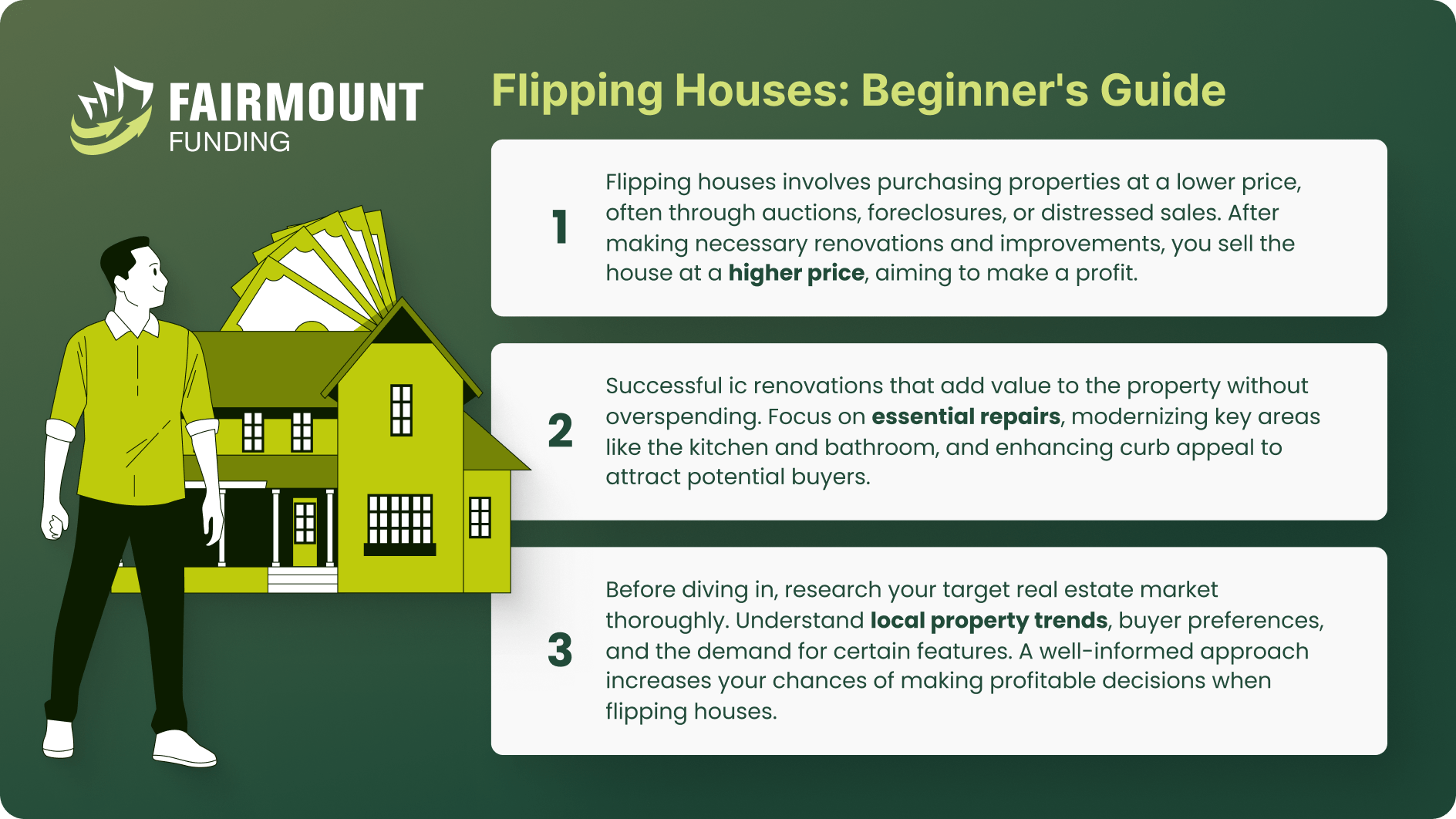
Different TV shows like Flip and Flop, Flipping 101, Hometown, and Property Brothers, highlight the quick and profitable transformations of rundown properties. These brief and dazzling shows make it look like flipping houses are easy, but the actual practice is far more intricate. Behind every eye-catching snapshot lies a tale of countless hours spent on renovation work, meticulous planning of design and budget, strategic marketing maneuvers, and the mental resilience required to overcome challenges.
Neglecting the fundamentals can result in eventual failure and many individuals, including real estate professionals, are prone to this error. So how do you ensure you will be successful in the house flipping business? Let’s learn together in this flipping houses 101 and start with the basics.
What is house flipping?
House flipping is like buying a fixer-upper house or a property you think will increase in value. Instead of living there, you aim to sell it quickly at a higher price, similar to selling a stock. Sometimes you fix up the house before selling, and other times you wait for its value to rise. The goal is to make a profit by buying low and selling high, usually within a few months to a year.
Pros and Cons of Flipping Houses
House flipping businesses, just like any other business, has its own risks. But doing it right will also reap you great rewards. Here’s some of the advantages and disadvantages of fix and flip houses:
Advantages of House Flipping
- Profit Potential: The primary benefit of flipping houses is the potential for substantial profits. Successfully buying low and selling high can yield significant returns in a relatively short time period.
- Work Flexibility: It is flexible in terms of when and how you work. Some investors work based on their availability and use it as an additional stream of income aside from their primary job. It could also suit those who prefer project-based work rather than a traditional 9-to-5 job.
- Enhance Community Value: Individuals involved in flipping houses invest in improving the physical condition of properties they purchase. Vacant or run-down properties can become eyesores and contribute to a sense of neglect in a neighborhood. By purchasing and renovating these properties, house flippers help to eliminate blight and contribute to a more appealing and vibrant community.
Disadvantages of House Flipping
- Time-Intensive: Renovations and property management demand substantial time and effort. Flippers often underestimate the time required for renovations and market preparation. The pressure to make quick decisions, manage budgets, and meet deadlines can lead to high levels of stress and burnout.
- Financial Risk: Flipping houses can be highly risky. Unexpected expenses, market downturns, or failure to sell quickly can lead to financial losses. A sudden shift in local housing trends can negatively impact your potential profits.
- Legal and Regulatory Challenges: Flipping houses involves navigating various legal and regulatory requirements, such as permits and zoning rules, which can be complex and time-consuming.
7 Steps to Start a House Flipping Business
The key to success in house flipping isn’t merely about picking out paint colors and arranging furniture. It involves comprehensive market research, astute financial planning, and the willingness to roll up one’s sleeves and tackle structural and aesthetic improvements. Here’s how to get started with flipping houses:
Step 1: Set a Budget
A significant financial challenge arises when insufficient funds are available to support your project’s financing. The amount you believe is adequate likely falls short, especially if you’re new to this experience. It is advisable to conduct a comprehensive analysis of the project’s expenses and potential revenue. Do research on similar projects or initiatives to gain insights into potential costs and challenges and seek advice from experts or individuals who have experience in similar endeavors.
Step 2: Find a Distressed Property
If your budget isn’t substantial, focus on identifying properties that align with your current financial resources. Explore options like foreclosures, auctions, and short sales to find properties that suit both your budget and renovation capabilities. Consider enlisting the support of a seasoned real estate agent who specializes in working with property renovators. Such an agent can assist you in researching comparable properties and projecting price growth, aiding in the selection of neighborhoods and homes that offer optimal return on investment (ROI).
Step 3: Secure Your Funds
The availability of funds directly influences the feasibility and success of flipping houses. Adequate funding not only facilitates the smooth execution of tasks but also serves as a safeguard against unexpected challenges or setbacks that may arise during the course of the project. Diversifying funding sources is a prudent strategy to mitigate risks associated with relying on a single channel. A few avenues include securing fix and flip loans, seeking partnerships, exploring grants, and engaging in crowd-funding. Each funding source that provides fix and flip loans for beginners has its own set of requirements and benefits, making it key to align the choice of funding with the nature and goals of the initiative. Setting aside contingency funds to account for unexpected expenses or unforeseen circumstances will also help you along the way.
Step 4: Make an Offer
Once your financing is organized and you’ve identified the suitable property, you’re ready to proceed with submitting an offer. Seasoned property renovators commonly assess a property’s post-repair value, using a specialized formula to ascertain its eventual market value. This calculation aids in determining an appropriate bidding amount. Should an offer not result in a successful deal, don’t be discouraged—maintain a list of alternative properties in case any of your prospects don’t materialize as planned.
Step 5: Set a Timeline
Property renovations vary significantly in terms of both required finances and time commitments. This diversity underscores the importance of recognizing that distinct projects demand distinct durations for completion. Whether the renovation timeline extends to a mere month or stretches across six months, it is imperative to allocate a sufficient time frame to execute the necessary repairs and enhancements. Additionally, it’s crucial to account for any necessary building inspections within the designated time frame to ensure compliance with regulations and standards.
Step 6: Hire a Contractor
If you lack the skills to manage repairs and renovations independently, it’s advisable to enlist trustworthy professionals to handle the required tasks. While certain contractors may have comprehensive teams for various aspects of the project, this isn’t universally the case. It’s crucial to assess licenses and references of potential contractors and ensure their price estimates align with your budget and project timeline.
Step 7: Sell Your Property
Once the renovations are complete, the next step is to list your property for sale. While selling on your own is an option, enlisting the services of a real estate agent can be advantageous. They possess the expertise to effectively market your property to targeted buyers, broadening your potential buyer pool and increasing your chances of a successful sale.
Can I start flipping houses without money?
Just to be clear, it is totally possible to learn how to flip houses with no money but how to start flipping houses with no money requires help from a community of investors and lenders who have the capacity to provide the fundings that you need to complete your first deal. There are numerous funding avenues that you can take advantage of if you don’t have the capital to start a project. Some of these include private lenders, hard money lenders, home equity, crowdfunding, or partnering with house flipping investors. The fastest way to succeed is often by using money from others, however, it’s essential to identify the right sources.
Flipping Houses FAQs
What are the common mistakes I should avoid when starting a house flipping business?
Flipping houses can be lucrative, but success requires significant capital, expert guidance, and preparation. Common mistakes to avoid include underestimating budget needs, misconceiving the simplicity of the process, neglecting to build a skilled team, and attempting it part-time. Committing time, money, and effort is crucial for profiting from house flipping.
How much can I make flipping houses?
Based on data provided by property data firm ATTOM, the average profit from these sales is $67,900. While this might seem like a significant amount, it marks the lowest value since the housing market crash that led to the 2008 financial crisis.
How much does it cost to flip a house?
How much does it cost to flip a house can vary widely depending on factors such as location, property size, extent of renovations needed, and local market conditions. The 70% rule is a guideline often used by real estate investors to estimate the maximum purchase price for a property in order to ensure a profitable flip. According to this rule, the total cost of acquiring the property (including purchase price, renovation costs, and other expenses) should not exceed 70% of the expected after-repair value (ARV) of the property.
For example, if the projected ARV of a property is $300,000, the maximum amount an investor should be willing to spend on acquiring and renovating the property would be $210,000 (70% of $300,000). This includes both the purchase price and all renovation expenses.
The True Effort Behind the Glamor of Flipping Houses
While TV shows on flipping houses might present it as easy and glamorous, the reality is far from such a polished image. Beneath the captivating exterior lies dedication and hard work. While the glitzy portrayals of house flipping on screens might captivate audiences, the reality is a labor-intensive journey requiring commitment and skill. Meticulous research, skilled craftsmanship, and strategic decision-making merge to bring properties to life. It requires thorough research to ensure the right buying and selling prices, along with physical labor for necessary repairs. Building a capable team for tasks beyond your expertise is crucial.
Additionally, unexpected challenges can arise, potentially leading to financial losses instead of profits. However, approaching them with adaptability and determination can turn potential setbacks into valuable learning opportunities that can pave the way for success. Embrace the challenge with open arms, knowing that the true effort you put in will be the driving force behind the ultimate glamor of a profitable project.
KEY TAKEAWAYS
- House flipping is an enterprise that thrives on expertise, meticulous preparation, and astuteness for attaining success.
- Disregarding the basics in flipping houses can lead to ultimate failure.
- Flipping houses without money involves partnering with investors and lenders who can provide the needed financing for your initial project.


